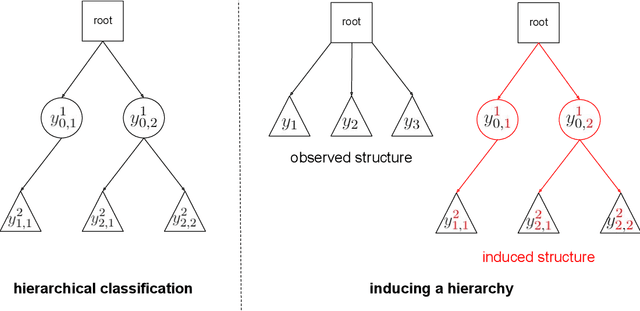Sujeeth Bharadwaj
Inducing a hierarchy for multi-class classification problems
Feb 20, 2021


Abstract:In applications where categorical labels follow a natural hierarchy, classification methods that exploit the label structure often outperform those that do not. Un-fortunately, the majority of classification datasets do not come pre-equipped with a hierarchical structure and classical flat classifiers must be employed. In this paper, we investigate a class of methods that induce a hierarchy that can similarly improve classification performance over flat classifiers. The class of methods follows the structure of first clustering the conditional distributions and subsequently using a hierarchical classifier with the induced hierarchy. We demonstrate the effectiveness of the class of methods both for discovering a latent hierarchy and for improving accuracy in principled simulation settings and three real data applications.
Training Large Neural Networks with Constant Memory using a New Execution Algorithm
Feb 22, 2020



Abstract:Widely popular transformer-based NLP models such as BERT and GPT have enormous capacity trending to billions of parameters. Current execution methods demand brute-force resources such as HBM devices and high speed interconnectivity for data parallelism. In this paper, we introduce a new relay-style execution technique called L2L (layer-to-layer) where at any given moment, the device memory is primarily populated only with the executing layer(s)'s footprint. The model resides in the DRAM memory attached to either a CPU or an FPGA as an entity we call eager param-server (EPS). Unlike a traditional param-server, EPS transmits the model piecemeal to the devices thereby allowing it to perform other tasks in the background such as reduction and distributed optimization. To overcome the bandwidth issues of shuttling parameters to and from EPS, the model is executed a layer at a time across many micro-batches instead of the conventional method of minibatches over whole model. In this paper, we explore a conservative version of L2L that is implemented on a modest Azure instance for BERT-Large running it with a batch size of 32 on a single V100 GPU using less than 8GB memory. Our results show a more stable learning curve, faster convergence, better accuracy and 35% reduction in memory compared to the state-of-the-art baseline. Our method reproduces BERT results on any mid-level GPU that was hitherto not feasible. L2L scales to arbitrary depth without impacting memory or devices allowing researchers to develop affordable devices. It also enables dynamic approaches such as neural architecture search. This work has been performed on GPUs first but also targeted towards high TFLOPS/Watt accelerators such as Graphcore IPUs. The code will soon be available on github.
 Add to Chrome
Add to Chrome Add to Firefox
Add to Firefox Add to Edge
Add to Edge